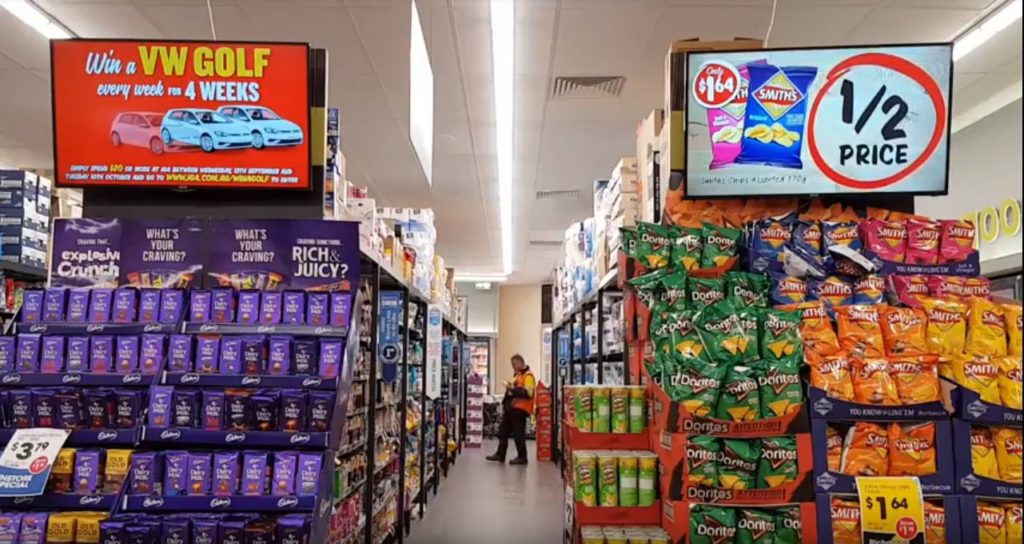Many brick-and-mortar retailers are starting to work on creating distinct in-store experience to better connect with their customers and to differentiate from competitors including eCommerce competitors.
One of the ways retailers are rethinking the in-store experience is to introduce digital experience into stores through digital signage. Even simple digital signage seems to be working. Nielsen tracked 120 grocers who use digital signage in their stores, they found that 80% of them saw as much as a 33% boost in sales compared to using printed signs.
Digital signage is one of the most effective ways for retailers and brands to deliver compelling brand messaging to shoppers where they are making their buying decisions.
However, much of the existing digital signage is nothing more than a slide show of static images (which is still more effective than printed posters) or playing canned branded adverts, the digital medium offers so much more opportunity to engage with the shopper. You may be able to capture shoppers attention with bright lights and colourful images, but retaining the attention demands content that pays attention to customers needs.
The dynamic nature of digital signage also gives stores the opportunity to shape, adapt and test promotions and content continuously. When partnered with in-store customer and eye tracking technology there is an opportunity to deliver content that is more relevant to the demographics of the shoppers that are in the store.
Why is digital signage effective for creating in-store experiences?
Digital signage with motion is more eye-catching and memorable than static media
You will know from personal experience that it’s hard to resist looking at screens. The combination of bright colors, motion and beautiful displays are hard to miss even when you may want to ignore it. It attracts attention more than any other medium.
The fact that the eyes (even busy ones) will be attracted increases the number of views and ultimately improve the chances of influencing shoppers. Studies show that motion content is 81% more effective in grabbing attention when compared to static.
Delivering multiple messages in a short span of time
One of the benefits of digital signage is that you can deliver multiple advertisements or messages from a smaller amount of real estate. For example, if you cycled through 5 ads on a screen you would need the equivalent of 5 static posters to present the same messages.
However, it is important to understand the attention potential of screen placement. A screen in a checkout area could afford to have several minutes of content but a store entrance where customers are passing through quickly may only have 10 – 15 seconds of a shoppers attention.
Although a digital screen can run multiple ads it is still expensive real estate, so you want to make sure the ads and messages are effective, relevant and appropriate for the “attention potential” of a screens position.
Customisable content
Unlike television (“broadcasting”) the content of in-store digital signage (“narrowcasting”) can be completely tailored and sent to specific screens (locations) at specific times. This allows you to communicate directly with your shoppers with the right message, at the right time.
Combine both shared and local content
Digital signage allows for a combination of central (shared) content with local store content. An example is being able to support a national video advertising campaign with local store pricing in real-time. The ability to deploy the content at any time and location and localise it with real-time POS pricing and offers is more dynamic than any other store-based advertising medium.
Personalised content
Due to the advent of online-advertising, personalised content is now an expected part of the modern shopping experience. IoT technologies and Big Data when integrated with digital signage can be used to create real-time personalised content that provides shoppers with location-based offers and information that is specific to them.
What are the benefits of in-store digital signage?
Attract window shoppers and passing foot traffic
One of the greatest challenges in retail is getting a new customer through the door. Digital signage can help to create more engaging window and entry displays because the colour and movement of digital screens is the best way to attract the shopper attention. It is then up to the quality of the content or offer presented to draw the shopper into the store. Printed and static signs is limited in its ability to attract and engage with window shoppers.
Increasing basket size
There are many studies over many years that show the effectiveness of in-store signage. Digital is just an evolution of this and numerous studies have shown it to be more effective than the traditional static signage. In-store digital signage can be an engaging way to highlight offers, up-sell and cross-sell. Retail case studies showing sales uplift of 10% to 25% across advertised products.
A Nielsen survey showed that 42% of 1000 shoppers said they would rather shop at a store with digital displays and that 68% of those shoppers said in-store messages would sway their purchasing decisions. Another report by Arbitron Research found that of those shoppers who have seen in-store digital signage, almost 30% made an unplanned purchase as a result.
Highlighting new products
One of the advantages of bricks-and-mortar stores is providing shoppers an environment where they can browse and discover new products. Digital signage can aid in the discovery of new products by calling them out. This discovery experience is not easily replicated for many online retailers and can become a key ingredient for a good in-store customer experience.
Up-selling and cross-selling
Cross-selling has exploded online as the digital platform is a perfect medium for easily showing “customers also purchased” and bundle promotion offers. The in-store strategy is to place complementary items alongside one another in stores. However, there are limits on how many products you can physically co-locate to take advantage of this effect.
Digital signage is very effective in delivering these messages and you may even start seeing messaging in-store that you see online such as, “If you like this, you may like this”.
Display cross-merchandising combinations which tap into shopper missions.
When you know your customer missions, you’re able to create cross-merchandising messages and when shoppers can relate to the messages, they’re more likely to be persuaded to make a purchase.
But more importantly, the decisions on which products to cross-merchandise can be data driven, by understanding historical buying patterns. Using this historical data, the creation of cross-merchandising advertising can be largely automated and does not require constant product location changes.
Leverage out-of-store media campaigns
Many retailers and brands spend thousands (and even millions) creating out-of-store advertising for TV and online but do not take advantage of that advertising content once shoppers are in the store.
By re-purposing out-of-store content for in the store, you can maximise the return on the advertising and production spend. Most importantly you are using the content at the point where it has the greatest change of influencing the buying decision, in the store.
Bring your online marketing efforts in-store
We have seen that bricks-and-mortar stores competing with eCommerce on factors like ease and convenience isn’t a long term winning strategy for retail. With tools like digital signage, it doesn’t have to be one sales channel over another. Digital signage allows physical store to benefit from some of the online digital marketing efforts. It allows you to present valuable social proof (like social media posts from customers and online reviews) and re-purpose online content for viewing in the store.
Promoting new forms of shopper engagement
Digital signage is not always about presenting offers and product ads, it is a great way of informing shoppers of your social media platforms such as Facebook pages or loyalty programs. There is no better time or location to inform shoppers of the value of joining a loyalty program when they are faced with tangible product offers and savings in the store.
Showcase brand advocates
Word-of-mouth marketing has become even more important with social media. Satisfied customers can become powerful brand advocates. Digital signage is a great medium for presenting shoppers stories and product reviews. This brings the power of brand advocates into the store for those shoppers that don’t engage on social media.
Increase awareness of ‘soft’ marketing initiatives
Sponsorship and community support initiatives are very powerful for creating socially responsible brand but it is very difficult to promote these community based initiatives in the media. Digital signage is a very effective and inexpensive way to inform your customers about these initiatives to generate good will and build trust in your brand.
Tell your brand’s story
With printed signage, you’re limited by space and it is very difficult to convey your brand story to your customers. Digital signage removes those limits and allows you to tell more complex and expressive brand stories.
What's next?
We hope you found these ideas useful. If you'd like to discuss how Last Yard can help create a connected store and enhance your retail in-store experience, get in touch today.
Like to see these strategies in action? Book a discovery call for a quick 15-minute demo with real-world examples you can share with your team.


